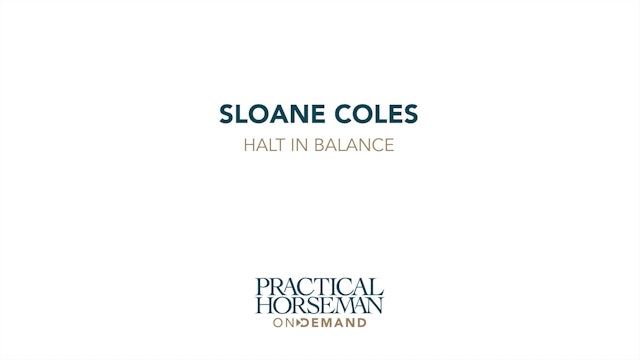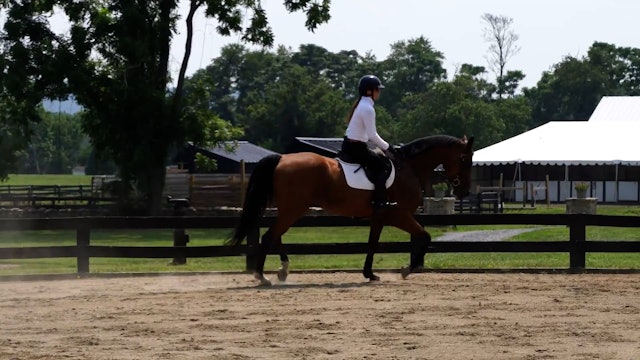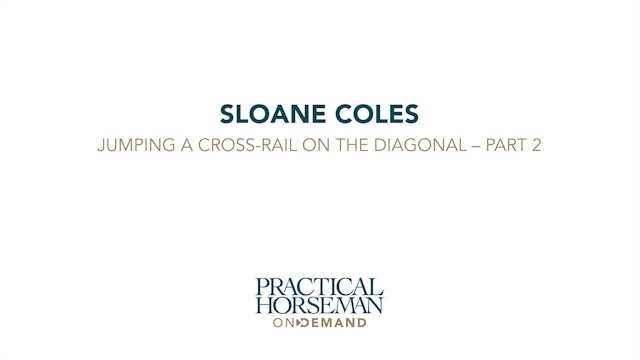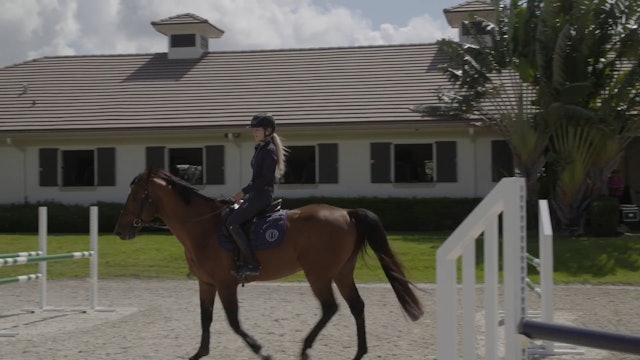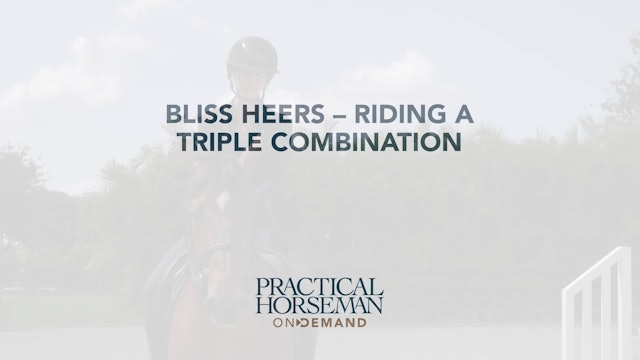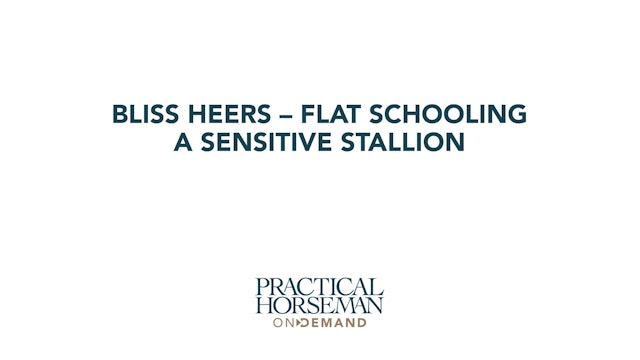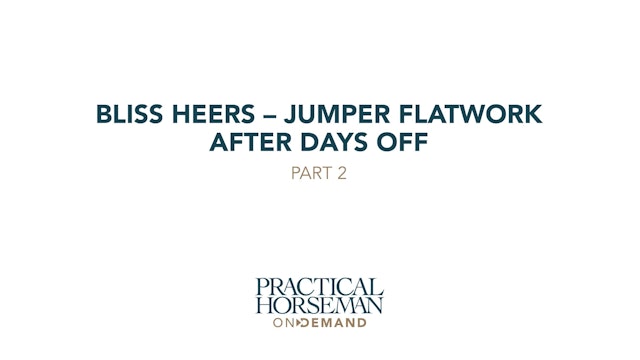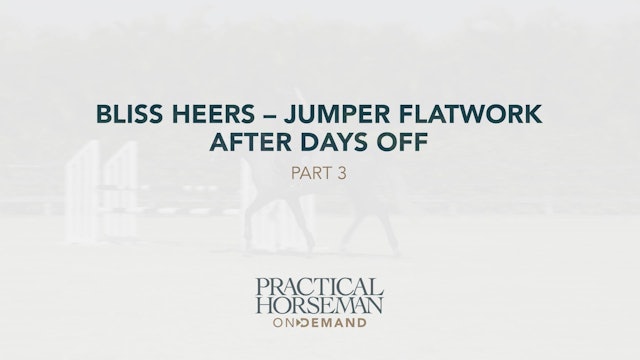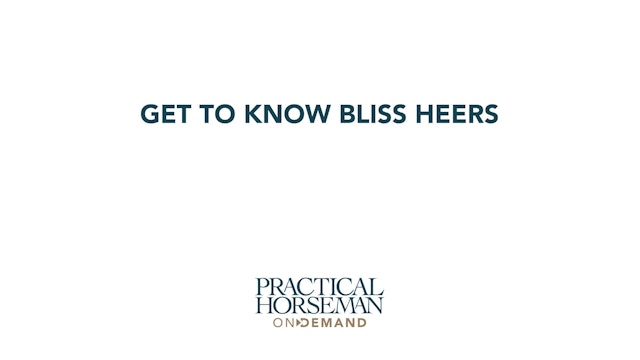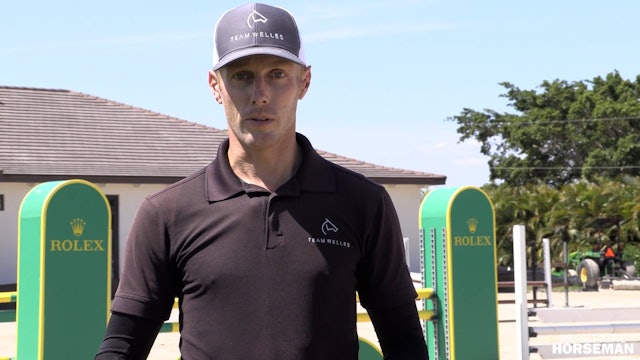Jumping
The Olympic sport of show jumping is scored objectively based solely on the horse’s athletic ability over fences as measured by time. A jumper’s only job is to clear all the fences in the course as quickly as possible without incurring any faults from knocking down a rail, refusing the jump or finishing over the allowed time. Search for your favorite coach or by training topic.
-
Halt in Balance | Sloane Coles
Nations Cup show jumper and successful hunter/equitation competitor Sloane Coles demonstrates the fundamental exercise of how to halt a horse straight and in balance from the walk, trot and canter. She explains the proper rider aids and position so that the rider does not only rely on the hands. ...
-
Lengthening and Collecting the Horse's Stride | Sloane Coles
In the first part of this exercise, Sloane demonstrates lengthening and collecting her horse's stride at walk, trot and canter. This is an exercise appropriate for all levels of horses and riders. She explains the rider aids necessary to complete smooth transitions within the gaits.
-
Jumping a Crossrail on the Diagonal | Sloane Coles | PART 01
Nations Cup show jumper and successful hunter/equitation competitor Sloane Coles demonstrates cantering a crossrail and how to break down the exercise to prepare for asking for a flying change after the jump. The exercise is about more than the flying change. It is also about balance, straightnes...
-
Jumping a Crossrail on the Diagonal | Sloane Coles | PART 02
In part 2 of this exercise, Nations Cup show jumper and successful hunter/equitation competitor Sloane Coles demonstrates cantering a crossrail and how to break down the exercise to prepare for asking for a flying change after the jump. It is important to work the horse in both direction because ...
-
Basic Gymnastic Work | Bliss Heers
Bliss does not regularly jump her horses much, but she does like to do gymnastics to help keep them fit and sharp. Here she is riding her 5* horse Antidote de Mars through a simple gymnastic pattern. It is also an exercise that can help the rider focus on position, rhythm and straightness.
-
Riding a Triple Combination | Bliss Heers
Bliss rides Antidote de Mars, her 5* grand prix jumper, through a triple combination, vertical-two strides to an oxer-one stride to a vertical. While many people get anxious approaching three fences in a row, Bliss says it is ridden with the same approach as one fence or a gymnastic line. The rid...
-
Flat Schooling a Sensitive Stallion | Bliss Heers
Bliss gives tips for schooling a horse that is nervous or overly aware of his surroundings. She says it’s about getting the horse comfortable in his surroundings so to help build his confidence, Bliss works him outside the arena and in places where he’s not familiar. She reminds us that the more ...
-
Jumper Flatwork After Days Off | Bliss Heers | PART 01
Bliss Heers shows her basic flatwork routine for a young stallion after having a few days off. She explains why she lengthens her stirrups for flatwork compared to the stirrup length for jumping. She warms up on a light rein contact with the focus on sending the horse forward and in front of the ...
-
Jumper Flatwork After Days Off | Bliss Heers | PART 02
Once the horse is relaxed and forward at the trot, Bliss moves on to canter. Again, she is not concerned with where the horse’s head is. She stays light in the saddle to allow him to move more freely under her. She stresses that issues like straightness, leaning on the hand and problems with flyi...
-
Jumper Flatwork After Days Off | Bliss Heers | PART 03
Once the horse is warmed up, Bliss starts to take more contact and asks the horse to bend from the inside leg into the outside hand. If the horse is fussy, she recommends going slightly more forward than what the horse naturally wants to do and keeping a consistent rein contact. She wants the hor...
-
Get to Know an Elite Show Jumper | Bliss Heers
Grand prix jumper rider Bliss Heers tells us how she got involved with horses and show jumping, who she has ridden with and how they have influenced her riding today.
-
Canter Control - Figure-Eight Pattern on the Flat | Andrew Welles | PART 01
Show jumper Andrew Welles explains how to use a figure-eight pattern to create a good base canter on the flat. His student comes forward through a turn, onto the diagonal and then collects so the horse coils like a spring and can rock back on his hind end. This is the same feeling a rider wants w...
-
Canter Control - Warm Up Before Jumping | Andrew Welles | PART 02
Show jumper Andrew Welles is in the irons warming up a young horse, making sure he is straight and forward in front of his leg. Andrew uses transitions—at the trot and canter—to ask the horse to step underneath himself and engage his hind end. This helps establish a base canter that he will use w...
-
Canter Control - Rideability Over Ground Poles | Andrew Welles | PART 03
Show jumper Andrew Welles rides over a straight line of three ground poles, collecting and lengthening the horse’s stride. He demonstrates adjusting the stride by riding the line in five strides, four strides and combinations of the two to help develop impulsion and he returns to the base canter ...
-
Day 1 Session 1 - Leg/Hand Feel | Anne Kursinski
Anne briefly talks riders through the importance of establishing and maintaining a leg to hand connection with the horse that does not come from the hand, but rather the seat and leg. Doing so creates a more consistent and true connection with the horse.
-
Canter Control - Jumping a Course | Andrew Welles | PART 04
Show jumper Andrew Welles reviews how he sets courses at home to incorporate elements of competition courses so they become routine. In schooling courses, he includes straight and bending lines, a plank, vertical-to-oxer and oxer-to-vertical combinations, a rollback turn and a liverpool. Then he ...
-
Day 3 Session 3 - Driving Rein Exercise | Anne Kursinski
Anne has riders turn their inside hand over so that they can't overuse the inside rein. With this rein position, they do lateral work, including shoulder-in. She also demonstrates how the horses can bend just from the leg and without any rein.
-
Horse and Rider Body Balance | Ronny Riemer
Horses do not like to be out of balance, and Ronny feels that the rider’s balance is extremely important to help the horse’s balance. He talks about how a rider should utilize their upper body, leg and hand to be in balance themselves, which helps the horse be in balance. He feels that the rider’...
-
Tips for Warmup on the Flat for Jumpers | Ronny Riemer
In this session from Equitana USA 2021, Ronny works with a rider and a 25-year-old Arabian and a rider with a 6-year-old Irish Sport Horse. In the warmup, he likes the horse to move freely forward with a soft connection in the hand. Too often, he says, he sees people in the warmup ring go straigh...
-
Trot Warmup for Jumpers | Ronny Riemer
When warming up a jumper horse, Ronny wants the hind end really moving and coming up underneath the horse. In addition, there needs to be a soft connection in front to allow the head, neck and shoulder to move freely and allow the hind end to step under.
-
Breakdown of Riding Aids and Body Balance | Ronny Riemer
Ronny considers the riding aids as the natural ones we have – the rider’s body (which should receive the biggest emphasis), the rider’s leg and the rider’s hand (which should receive the least emphasis). The rider’s body balance is the strongest aid on the horse.
-
Confidence Through Rhythm | Ronny Riemer
Ronny states that confidence for the horse can come through the rider maintaining a steady rhythm. He shows an exercise with two triangles of ground poles, which help the rider see how straight and rhythmical the horse is in the approach. The focus is on a forward rhythm while keeping the horse s...
-
Extension, Collection and Rollback in Trot and Canter | Ronny Riemer
Ronny watches the horses extend and come back in the trot and canter with the emphasis on coming back in balance to be able to correctly execute a rollback. He would like to see more body influence than hand when bringing the horse back.
-
Forward and Back in Canter | Ronny Riemer | PART 02
The horses should be able to freely move forward and back in the canter and bringing the horse back should mostly be done with the riders upper body. In a course if the rider collects the horse abruptly it could mess up the striding and distance to the next fence.



